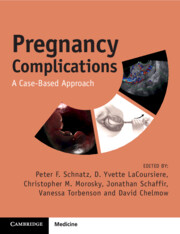Book contents
- Pregnancy Complications
- Pregnancy Complications
- Copyright page
- Contents
- Contributors
- Preface
- Note from the Editor-in-Chief
- Normal Laboratory Values (Conventional Units) []
- Section 1 Antepartum (Early Pregnancy)
- Section 2 Antepartum (Mid-trimester)
- Section 3 Antepartum (Late Pregnancy)
- Section 4 Antepartum (Medical Complications)
- Section 5 Antepartum (Infectious Complications)
- Section 6 Intrapartum/Delivery
- Section 7 Postpartum
- Section 8 Fetal Complications
- Section 9 Placental Complications
- Section 10 Complications of the Cord, Amnion, and Gravid Uterus
- Case 84 A 30-Year-Old Presents at 34 Weeks’ Gestation with Gestational Diabetes and a Fundal Height of 38 cm
- Case 85 A 30-Year-Old at 31 Weeks’ Gestation Presents with Oligohydramnios and Decreased Fetal Movement
- Case 86 A 35-Year-Old at 36 Weeks’ Gestation with a Unicornuate Uterus Desires an External Cephalic Version for Breech Presentation
- Case 87 A 40-Year-Old at 24 Weeks’ Gestation Presents with Multiple Fibroids Seen on Ultrasound
- Case 88 A 25-Year-Old at 13 Weeks’ Gestation Presents with Vaginal Spotting
- Case 89 A 35-Year-Old at 28 Weeks’ Gestation Presents with a Velamentous Cord Insertion Seen on Ultrasound
- Section 11 Psychosocial Considerations
- Index
- References
Case 84 - A 30-Year-Old Presents at 34 Weeks’ Gestation with Gestational Diabetes and a Fundal Height of 38 cm
from Section 10 - Complications of the Cord, Amnion, and Gravid Uterus
Published online by Cambridge University Press: 08 April 2025
- Pregnancy Complications
- Pregnancy Complications
- Copyright page
- Contents
- Contributors
- Preface
- Note from the Editor-in-Chief
- Normal Laboratory Values (Conventional Units) []
- Section 1 Antepartum (Early Pregnancy)
- Section 2 Antepartum (Mid-trimester)
- Section 3 Antepartum (Late Pregnancy)
- Section 4 Antepartum (Medical Complications)
- Section 5 Antepartum (Infectious Complications)
- Section 6 Intrapartum/Delivery
- Section 7 Postpartum
- Section 8 Fetal Complications
- Section 9 Placental Complications
- Section 10 Complications of the Cord, Amnion, and Gravid Uterus
- Case 84 A 30-Year-Old Presents at 34 Weeks’ Gestation with Gestational Diabetes and a Fundal Height of 38 cm
- Case 85 A 30-Year-Old at 31 Weeks’ Gestation Presents with Oligohydramnios and Decreased Fetal Movement
- Case 86 A 35-Year-Old at 36 Weeks’ Gestation with a Unicornuate Uterus Desires an External Cephalic Version for Breech Presentation
- Case 87 A 40-Year-Old at 24 Weeks’ Gestation Presents with Multiple Fibroids Seen on Ultrasound
- Case 88 A 25-Year-Old at 13 Weeks’ Gestation Presents with Vaginal Spotting
- Case 89 A 35-Year-Old at 28 Weeks’ Gestation Presents with a Velamentous Cord Insertion Seen on Ultrasound
- Section 11 Psychosocial Considerations
- Index
- References
Summary
Polyhydramnios, an abnormal increase in amniotic fluid, is estimated to affect 1–2% of otherwise low-risk singleton pregnancies. Ranging from mild to severe, underlying causes of polyhydramnios include fetal anomalies related to both production and resorption of amniotic fluid, genetic syndromes, maternal conditions, and infections. Routine measurement of fundal height is the screening modality recommended to assess for possible polyhydramnios given the known adverse outcomes. Once diagnosed, detailed anatomic assessment followed by antenatal testing is warranted to reduce associated adverse outcomes, including risk of fetal and neonatal demise in more severe cases. Optimizing delivery timing and planning is paramount to reduce known risks including cesarean delivery, operative delivery, postpartum hemorrhage, and neonatal intensive care admissions.
- Type
- Chapter
- Information
- Pregnancy ComplicationsA Case-Based Approach, pp. 261 - 263Publisher: Cambridge University PressPrint publication year: 2025

